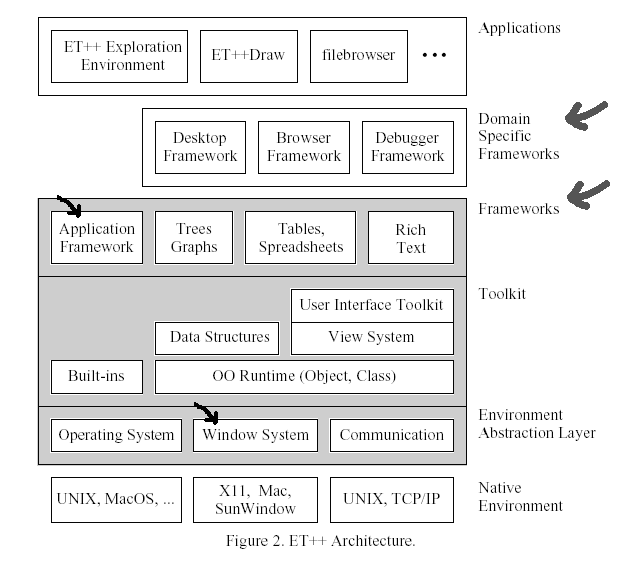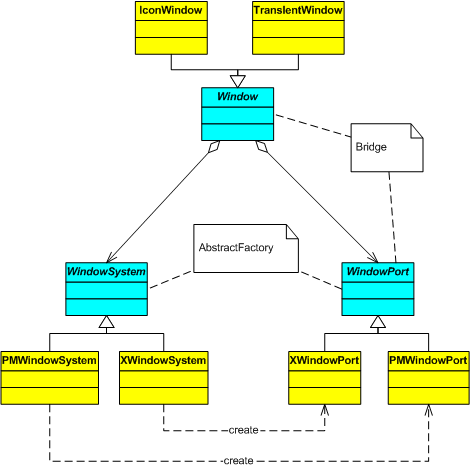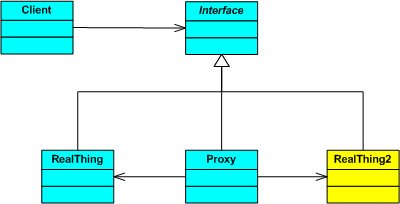Adapter,Bridge,Facade,Proxy。它们都是Structural Patterns,它们的关系如下图所示:  ●Tip 1:关键字。existing,reuse。 ●Tip 2:图。  ●Tip 3:实现和使用。到底使用Class Adapter还是Object Adapter,要视不同情况而定。 Class Adapter优点:Lets Adapter override some of Adaptee's behavior, since Adapter is a subclass of Adaptee。另外,不必引入额外的实例化问题,Introduces only one object, and no additional pointer indirection is needed to get to the adaptee。 Class Adapter缺点:Adapts Adaptee to Target by committing to a concrete Adapter class. As a consequence, a class adapter won't work when we want to adapt a class and all its subclasses. Object Adapter优点:Lets a single Adapter work with many Adaptees─that is, the Adaptee itself and all of its subclasses (if any). The Adapter can also add functionality to all Adaptees at once. Object Adapter缺点:Makes it harder to override Adaptee behavior. MFC本身就是Adapter的例子,Win32 API是基于func的,MFC是基于class的。 ●Tip 4:优点。可用于整合遗留系统。 ●Tip 5:局限性。如果遗留系统还在发展、变化和增长之中,整合的开销会很大。 ----------------------------------Bridge---------------------------- ●Tip 1:关键字。Abstraction and its Implementation。 ●Tip 2:图。  Application层的Client使用Abstraction层的抽象对象,这些抽象对象是和具体平台无关的;Abstraction层的抽象对象又是由Implementor层的对象实现的,和具体平台有关的对象在Implementor层;为了更加清晰地说明问题,我在Abstraction层和Implementor层之间增加了Logic层,该层是Implementor如何实现Abstraction的程序逻辑。 其实,Bridge模式是非常典型的Layer-like模式。为了对比方便,我放一张ET++的Layer图在下边。  在此集中讨论一个问题:RefinedImplementor的实例化问题。因为RefinedAbstraction肯定是由Client实例化的,但RefinedImplementor的实例化却可以分为2种情况: 第1种情况,由Abstraction或RefinedAbstraction实例化。这要求Abstraction或RefinedAbstraction知道所有的RefinedImplementor,具体实例化哪一个,可以通过Abstraction::Abstraction(para)的参数来确定。 第2种情况,委托给别的对象来实例化。典型的,可以委托给一个Abstract Factory来实例化。这样,Abstraction只需要知道Implementor这个Interface,这是一个良性依赖,在图中被我画成了绿色。 ET++中,和平台无关的Window是用和平台相关的WindowPort实现的,但后者的实例化是委托(delegate)WindowSystem这个Abstract Factory来完成的: class Window {
...
protected:
WindowImp* GetWindowImp(); ///////////////call Abstract Factory and return Implementor
private:
WindowImp* _imp; ////////////save GetWindowImp() 's return value
...
};
WindowImp* Window::GetWindowImp () {
if (_imp == 0) {
_imp = WindowSystemFactory::Instance()->MakeWindowImp();////////////////////WindowSystemFactory is a Singleton
}
return _imp;
}
 ----------------------------------Proxy---------------------------- ●Tip 1:关键字。Placeholder,Control。 ●Tip 2:图。  ●Tip 3:实现和使用。讨论两个关键字: Placeholder。可以是a direct reference to its real subject,比如在同一台PC上(且在同一个Application内),DrawProxy之间调用Draw;也可以是only an indirect reference,比如跨网络的应用,可能只知道“host ID and local address on host”,哈哈,就是“IP地址+端口号”。 Control。之所以Proxy,就是为了能Control,或者说为了智能:智能保护,智能拒绝,智能回收,智能降低开销。 在COM中,有智能指针SmartPointer。.Net中的SmartClient说不定也是。。。 ----------------------------------Facade---------------------------- ●Tip 1:关键字。Subsystem,Higher-level Interface。 ●Tip 2:图。  ●Tip 3:实现和使用。 在Facade Class上还可以做些文章,以进一步降低耦合度,比如Facade本身可以派生Subclass,或者用委托(delegate)来配置Facade。The coupling between clients and the subsystem can be reduced even further by making Facade an abstract class with concrete subclasses for different implementations of a subsystem. Then clients can communicate with the subsystem through the interface of the abstract Facade class. This abstract coupling keeps clients from knowing which implementation of a subsystem is used. An alternative to subclassing is to configure a Facade object with different subsystem objects. To customize the facade, simply replace one or more of its subsystem objects. 使用名字空间。A class encapsulates state and operations, while a subsystem encapsulates classes. The C++ standardization committee added name spaces to the language [], which will let you expose just the public subsystem classes. 在ET++中,有个称为browsing tools的Subsystem,其中的ProgrammingEnvironment就是Facade。ET++中的相关研究,请参考本站(lcspace.nease.net)的Framework栏目。 ●Tip 4:支持变化。Lets you vary the components of the subsystem without affecting its clients。 ----------------------------------Proxy and Decorator---------------------------- ●Tip 1:Proxy是Decorator特例。 当一个Decorator模式,Decorator不能递归修饰Decorator,而且也不要before forwarding和after forwarding的操作了,仅仅就是forward,Decorator模式也就退化成Proxy模式了。 ----------------------------------Adapter,Bridge,Facade and Proxy---------------------------- Adapter,Bridge,Facade and Proxy这4种模式,其实都可以归为“Layer-like模式”。想想看,它们确实都是“Layer间单向调用服务”的。 当然,从逻辑上来讲,这4个模式又分为2组: Bridge and Facade──涉及逻辑层次“不同”的2个Layer。 Adapter and Proxy──涉及逻辑层次“相同”的2个Layer。 下面是典型的Layer-like模式的示意图: 
|